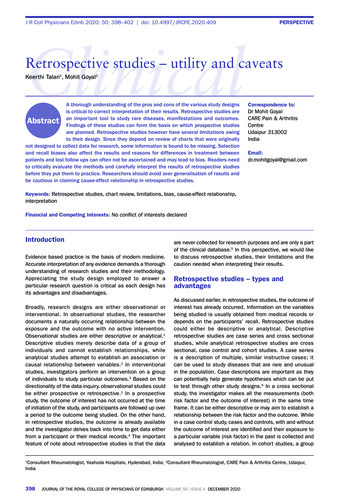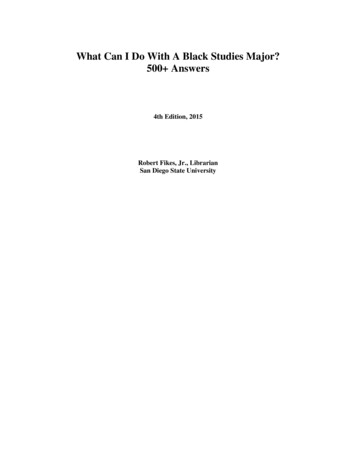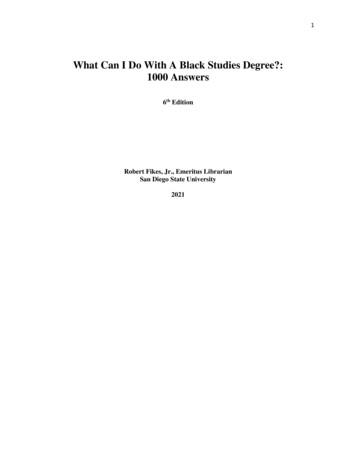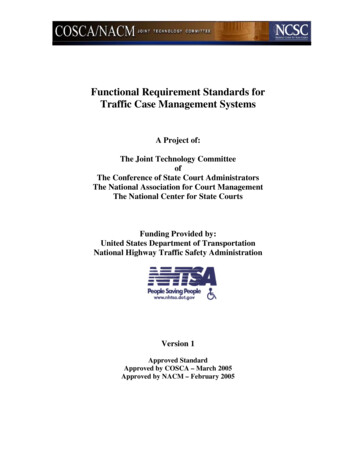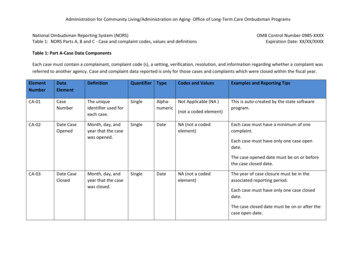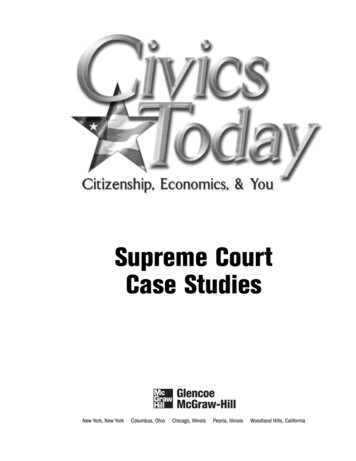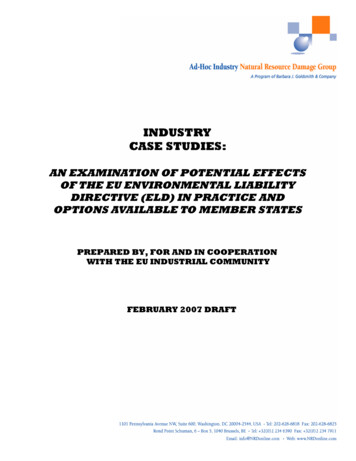
Transcription
INDUSTRYCASE STUDIES:AN EXAMINATION OF POTENTIAL EFFECTSOF THE EU ENVIRONMENTAL LIABILITYDIRECTIVE (ELD) IN PRACTICE ANDOPTIONS AVAILABLE TO MEMBER STATESPREPARED BY, FOR AND IN COOPERATIONWITH THE EU INDUSTRIAL COMMUNITYFEBRUARY 2007 DRAFT
FOREWORDTransposition of the European Union (EU) Environmental Liability Directive (ELD) intothe national laws of each Member State is required by April 30, 2007. Member Statesare in the process of drafting national legislation transposing the ELD. Completion ofthis transposition process will mark the end of the legislative activity, and the beginningof environmental remediation practice under the Directive.During a June 2006 meeting with the European Commission, DG Environment,attended by EU-based companies and associations, we first began to explore thepossible value of a case studies document, prepared by industry, to explore practicalimplementation issues. When the ELD, the national laws transposing the ELD, and thepre-existing framework of national laws need to be applied to real-life cases ofenvironmental damage, many issues will arise for which the laws will not provide asimple, obvious and undisputed answer. The Competent Authorities and other partieswill be faced with a plethora of options, choices and decisions. We concluded that acase studies document would be useful to illustrate the expected effects of the ELD inactual practice and explore accompanying issues. The preparation of the case studieshas been a collaborative effort, based on the collective experience of a wide range ofcompanies and their experts.The case studies were first presented and discussed at the Workshop “EnvironmentalLiability – Enhancing the Development of Viable Insurance Solutions in the InternalMarket”, convened by Comite Europeean des Assurances (CEA) in Brussels on 18January 2007.We hope that this case studies document will be useful to the industrial community asit works with individual Member States to finalize proposed national ELD regimes andalso, after the law takes effect. The document may also be helpful to nationalauthorities in developing guidelines on the ELD transposing legislation.This document may be revised from time to time. We invite your comments andsuggestions.BrusselsFebruary 2007FEBRUARY 2007 DRAFTEU PROGRAMME, AD-HOC INDUSTRY NATURAL RESOURCE DAMAGE GROUPwww.nrdonline.com/EUELDPage i
TABLE OF CONTENTSSectionPageFOREWORDiEXECUTIVE SUMMARY1INTRODUCTION4BACKGROUND FACTS4CASE 1: EXPLOSION AND FIRE7CASE 2: TANK FAILURE15CASE 3: RAIL CAR19CASE 4: OIL SPILL23PRINCIPLES AND RECOMMENDATIONS29SUMMARY31FURTHER INFORMATION29APPENDICESTechnical Appendix A: Discussion of Selected Key IssuesFEBRUARY 2007 DRAFTEU PROGRAMME, AD-HOC INDUSTRY NATURAL RESOURCE DAMAGE GROUPwww.nrdonline.com/EUELDPage iiI
LIST OF TABLES AND FIGURESTable/Figure NumberTitlePageTable 1SUMMARY OF CASES2Figure 1BACKGROUND FACTS6Figure 1-1CASE 1: EXPLOSION AND FIRE7Figure 2-1CASE 2: TANK FAILURE15Figure 3-1CASE 3: RAIL CAR19Figure 4-1CASE 4: OIL SPILL23FEBRUARY 2007 DRAFTEU PROGRAMME, AD-HOC INDUSTRY NATURAL RESOURCE DAMAGE GROUPwww.nrdonline.com/EUELDPage iii
EXECUTIVE SUMMARYThis document presents four main cases (designated as Explosion and Fire; TankFailure; Rail Car; and Oil Spill) under the requirements of the European Union (EU)Environmental Liability Directive (ELD). A number of scenarios have been identified inrelationship to each of the four main cases in order to ensure that a sufficientlycomplete and realistic set of cases/scenarios are presented.Taken together, the case studies demonstrate that legal and technical practice underthe Environmental Liability Directive is likely to be complex. In many cases, thecompetent authorities and the potentially affected industrial parties will need tocarefully assess site-specific circumstances in order to correctly interpret theapplicability of the ELD, identify the resources affected and the services lost, anddetermine the actions necessary to restore the affected resources. Table 1 summarizessome of the key legal, technical and economic issues and questions raised by thevarious case studies. They include: How to determine whether the ELD applies in a specific situation;How to ensure that there is a link between the release in question and theadverse conditions observed (causation);How to determine the primary, complementary and compensatory remediationthat is appropriate at a specific site;How to deal with uncertainty and methodological limitations;The role of baseline; andThe application of exceptions and defences.The cases studies underscore the complexity, and in some cases, also the ambiguity,embodied in the ELD’s requirements. It will be important that the ELD regimes that aredeveloped by individual Member States be balanced, reasonable and predictable.Readers of the case studies that follow should bear in mind that the fact patterns andimplementation issues they explore are only illustrative of the many different variationsthat will arise in actual practice. Our intent in raising the issues explored in the casestudies is to begin a dialogue on how to implement the ELD in a manner that isbalanced, reasonable and predictable.We do not suggest that Member States or other parties seek to shape implementinglegislation in response to the very specific fact patterns illustrated in the case studies,because they represent only a small segment of the fact patterns and issues that arelikely to arise over time. Rather, the implementing legislation should assure creation ofa balanced, reasonable and predictable liability regime, and within that context,preserve flexibility to respond appropriately to implementation issues as they arise -leaving further details to be developed in guidance materials and implementationpractices. Experience suggests that simple and clear legislation and guidelines willfacilitate dealing with some of the potential complexities identified here in an effectivemanner. To help guide implementation, we suggest at the conclusion of the case studiessome principles and recommendations that we believe will help parties to respondappropriately to the unforeseen issues and complex fact patterns that will likely emergeas implementation of the Directive proceeds.FEBRUARY 2007 DRAFTEU PROGRAMME, AD-HOC INDUSTRY NATURAL RESOURCE DAMAGE GROUPwww.nrdonline.com/EUELDPage 1
TABLE 1SUMMARY OF INDUSTRIAL CASE STUDIESCASE/VARIATIONCASE 1EXPLOSION ANDFIREFEATURESUnintended chemical reaction leads to significantexplosion and fire. Various raw material and processliquids are released. Impacts on birds, fish andvegetation observed.Case 1-Variation 1Explosion and FireCase 1-Variation 2Explosion and FireCase 1-Variation 3Explosion and FireVolume of contaminated liquid is smaller and/or morediluted by the fire fighting water.Euro Industries was declared insolvent/bankrupt a yearbefore and continues to operate.Options are available to undertake complementary andcompensatory remedial measures.Case 1-Variation 4Explosion and FireStudies indicate that metals exposure of the migratorywaterfowl may have increased their susceptibility tobacterial infection and contributed to their death.100 year rainfall occurs leading to severe flood, causingtank to rupture and containment dike to fail. Damageoccurs that is within the scope of the ELD.CASE 2TANK FAILURECase 2-Variation 1Tank FailureFailure of the tank is due to a loss of structural integrityfrom corrosion.Case 2-Variation 2Tank FailureSpill occurred pre-ELD under former owner. Post-ELD,new owner finds previously unknown significantgroundwater migration.Case 2-Variation 3Tank FailureContamination occurs through intended discharge ofwastewater in accordance with a waste water dischargepermitRail car owned and operated by NRS at SME facility,spilling TCE owned by SME. No indication that TCE willpenetrate the aquitard or impact offsite resourcesCASE 3RAIL CARCase 3-Variation 1Rail CarClean up contractor installs but does not properly sealmonitoring well casings, allowing TCE, present as adense nonaqueous phase liquid (DNAPL), to move intoRegional AquiferCase 3-Variation 2Rail CarCase 3-Variation 3Rail CarTCE was produced, shipped, and owned by ACME.CASE 4OIL SPILLA barge carrying fuel strikes a dock, causing a spill of4,000 L of fuel oil. Half the volume moves downstream.Some NGOs call for remediation while other partiesbelieve it would be more disruptive than allowingevaporation to occur.Damage occurs in two Member States, one of which hasnot yet transposed the ELD.Six months after Case 4, the Competent Authorityreceives reports of oil sheen on the river with no obvioussource, but later determines the source is tank leak attruck fueling facility.After both Case 4 and Variation 2 occur, an NGO pointsout to the Competent Authority that there have beenmany releases into the river and asserting that theyshould all be addressed under the ELD.The barge delivering an organic chemical to Major MetalsCompany mistakenly discharges most of it into the river.The chemical is not considered to be hazardous, toxic,persistent, or bioaccumulative.Barge carried oil covered by one or more of theinternational oil pollution conventions listed in Annex IVof the ELD.Case 4-Variation 1Oil SpillCase 4-Variation 2Oil SpillCase 4-Variation 3Oil SpillCase 4-Variation 4Oil SpillCase 4-Variation 5Oil SpillDerailment and spill result from sabotage by adisgruntled former employee of NRSISSUES1. Applicability of the ELD2. Causation3. Burden of proof4. Primary remediation5. Compensatory remediation6. Service-to-service versus resource-toresource scaling7. Preventative action8. Sublethal effects1. ELD applicability2. Causation-uncertainty1. Operator definition2. Multiparty considerations1. Remediation with out-of-kind naturalresources2. Uncertainty1. Applicability of the ELD2. Service-to-service scaling3. Dynamic baseline1. Defences2. Exceptions1. Defences and exceptions2. Liability of previous owners3. Liability of professional inspectors1. Applicability of the ELD2. Baseline (pre- and post ELD releases)3. Liability4. Preventive action1. Permit compliance defence2. Compliance with orders and instructions3. Preventive action required by authorities1. Applicability of the ELD2. Operator definition3. Multiparty considerations4. Preventive action under Article 51. Operator definition2. Multiparty considerations3. Differences between Annex III parties andnon-Annex III parties4. Remedy cost-benefit.1. Operator definition2. Multiparty issues1. Third party causation2. Scope of damage covered by ELD3. Concurrent civil and administrative actions1. ELD applicability2. Operator definition3. Multiparty issues4. Baseline condition5. Remediation versus natural recovery1. ELD Applicability1. Administrative remedies2. Applicability of directive3. Multiparty issues.1.2.3.4.1.Applicability of ELDDiffuse sources and causationPreventive action under Article 5Defences and exceptionsState-of-the-Art defence1. International oil pollution conventionsexception.2. Liability limitations under LLMC and CLNI.3. Interim lossesFEBRUARY 2007 DRAFTEU PROGRAMME, AD-HOC INDUSTRY NATURAL RESOURCE DAMAGE GROUPwww.nrdonline.com/EUELDPage 2COMMENTS
TABLE 1 (cont’d)SUMMARY OF INDUSTRIAL CASE STUDIESCASE/VARIATIONCASE 1EXPLOSION ANDFIREDISCUSSIONSIs dead water fowl covered by ELD? Are dead fish? How should Competent Authority (CA) respond to “other causes” claim? Shouldfurther investigation be conducted? Who has the burden of proof? Should the river be restocked? Should a quantitative assessmentof service losses and gains required? Do biomarker responses represent a "measurable adverse change"? How should CA respond torestoration of habitat? How much restoration is needed? How would potential ecological benefits of riparian restoration be scaledrelative to the lost services of temporarily decreased benthic macroinvertebrate abundance? Would a scaling factor other than 1:1 beappropriate? Is further investigation or preventative action required under the ELD once Euro Industries (EI)’ contractor removes andreplaces soil?Case 1-Variation 1Explosion and FireCase 1-Variation 2Explosion and FireWhat level of impact triggers application of the ELD? How should the CA deal with uncertainty?Case 1-Variation 3Explosion and FireCase 1-Variation 4Explosion and FireCASE 2TANK FAILURECase 2-Variation 1Tank FailureCase 2-Variation 2Tank FailureCase 2-Variation 3Tank FailureCASE 3RAIL CARCase 3-Variation 1Rail CarCase 3-Variation 2Rail CarCase 3-Variation 3Rail CarCASE 4OIL SPILLCase 4-Variation 1Oil SpillCase 4-Variation 2Oil SpillCase 4-Variation 3Oil SpillCase 4-Variation 4Oil SpillCase 4-Variation 5Oil SpillWho qualifies as an operator? What is the effect of the “decisive economic power” provision in the operator definition? Can GeneralIndustries (GI) be considered an operator by virtue of its parent company status and/or its environmental policies and practices?Can the Chairman of the Board of Directors be considered an operator? The bank? Is liability proportional or joint & several? Do EIand/or GI have any remedies against CA’s decision to attach its real estate and land?What are the main issues in evaluating whether the offer constitutes appropriate complementary and/or compensatory remediation?Is it important that the environmental damage caused by the incident be similar to the environmental benefit caused by preservationof the offered property? Or is it important only that the quantity of damage roughly equals the quantity of benefit as calculated undera methodology? How much uncertainty is acceptable in a HEA? How much reliance on professional judgment is acceptable in aHEA? Would an alternative valuation technique be required to demonstrate that the proposed remediation alternative results in a netenvironmental benefit? Could an agreement on remediation measures be reached without any valuation analyses? Is it sufficient thatthe property will be permanently preserved, or must EI also demonstrate that the conservation status of the property is likely tobecome impaired? Under what circumstances would it be appropriate to accept an offer of the type made by EI instead of requiringprimary remediation of the site affected by the release?Does increased bird mortality constitute "damage"? What additional information might be necessary to determine this? Factorsneeding consideration when determining how much enhancement would be needed include: a) increased susceptibility to bacterialinfection; b) determining the impact of the metals exposure in terms of services lost, How does one compare the services lost with theproposed service gain from breeding habitat enhancement? c) What if there is a non-static (dynamic) baseline in the breedingpopulation?; d) Are any considerations necessary with respect to long-term effects of the metal exposure?; What discounting factorwould be applied as part of the scaling process when evaluating those future gains in order to determine how much habitat must berestored to offset perceived losses? Is the offer potentially acceptable if the enhancement project is in another Member State? What ifthere is no breeding habitat in the affected Member State? Is the offer potentially acceptable if the enhancement project is in a nonEU country? What if there is no breeding habitat within the EU?Does this situation qualify for Article 4(1)(b) exception for “a natural phenomenon of exceptional, inevitable and irresistiblecharacter? Why or why not? Does it qualify for permit defence set forth in Article 8(4)? Why or why not? What are arguments for andagainst? Does dike failure along the river affect EI’s ELD liability?Does failure of previous owner or professional inspector to warn EI of tank corrosion problem affect EI liability? Does EI havedefences or exceptions to ELD liability? Is the previous owner or the professional inspector liable under the ELD?Is the ELD applicable? Is action required under the ELD? Who is responsible for the preventive action? Is Pre-ELD damage separatefrom post-ELD damage? How is baseline established? How can the preventive action and any remedial measures belimited to the post-ELD releases, to the exclusion of the pre-ELD releases, in accordance with the ELD?Can EI invoke permit compliance defence? Does NGO have claims? If Permit conditions are revised or withdrawn does it affect EI’sright to invoke the permit compliance defence? Can EI invoke defence of Article 8(3)(b)? What are EI remedies re: instruction to useunsuitable portable containers?Is the ELD applicable? Who is an operator? Can SME invoke the "third party" defence? Is liability proportional or joint & several?What can SME do if CA determines it is sole operator but SME thinks the rail road is sole operator? If SME refuses to remedy thedamage, what can the CA do? Should shallow groundwater be remediated? Could CA require preventive action?Is Ace an operator? What if cleanup exceeds Ace ability to pay? Can SME invoke "third party" defence? Is liability proportional orjoint & several? What is the applicability of ELD to the environmental damage or the scope of the operator's liability?Is Acme an operator? Is the existence of insurance or provision of detailed shipping specifications relevant? Is liability proportional orjoint & several?Can SME invoke "third party" defence? Can NRS? Can SME invoke "armed conflict" defence? Is personal injury and property damageaddressed under the ELD? Do civil proceedings affect any administrative action taken by CA?Is the ELD applicable? Does other legal framework apply? Who is the operator? Is liability proportional or joint & several? How arebaseline conditions established? How should CA respond to remediation v. natural recovery arguments? What if the recovery periodis much longer? How long is too long? Should rarity of plant species influence the decision? Should natural recovery be monitoredover a period of time?Is ELD applicable on the other side of the river? If not, how will remediation be addressed? Is it important that remediation proceedsconcurrently on both sides of the River? What are the mechanisms for coordination? Who might have claims on the east side?Is damage caused by ITF facility covered by the Directive? Who is the operator? Should liability be joint & several or proportional?What recourse do the Case 4 parties have, and what should CA do?Is the damage within scope of ELD? Should damage from multiple incidents be addressed under the ELD? How does CA evaluate andrespond to the request for preventive action under Article 5? How does the permit defence apply to damage from air emissions andnonpoint water discharges? Does exception for diffuse pollution apply?Is the state-of-the-art defence applicable?Does environmental damage fall under the ELD? Do liability limitations affect liability under the ELD? Does it affect liability of otherparties? Are there “interim losses”? How is this quantified? Does this affect required remediation?FEBRUARY 2007 DRAFTEU PROGRAMME, AD-HOC INDUSTRY NATURAL RESOURCE DAMAGE GROUPwww.nrdonline.com/EUELDPage 3
INTRODUCTIONThe European Union Directive on environmental liability with regard to the preventionand remedying of environmental damage was adopted by the European Parliament on21 April 2004. The Directive, known as the Environmental Liability Directive or ELD,makes Member States responsible for ensuring that "damage to water, land, andbiodiversity is either prevented, by taking appropriate measures in cases of imminentthreats, or effectively remedied by restoring the previous condition if the damage hasalready been done". The ELD’s fundamental principle is prevention of environmentalharm through the incentives generated by potential liability, based around the theorythat if operators are exposed to financial liabilities for damage, they will be induced toadopt measures and develop practices to minimize the risks of environmental damage.It is focused on restoration of injured resources in the event that damage does occur. By30 April 2007, Member States must “bring into force the laws, regulations andadministrative provisions necessary to comply with the Directive.” A wide range ofcompanies will be exposed to liability under the Directive, including transporters ordisposers of waste and hazardous waste, companies whose operations result in adischarge of dangerous substances or genetically modified organisms, and otherindustries. It subjects operators of activities covered by listed EU environmentaldirectives to strict liability and operators of other occupational activities to fault ornegligence liability. It incorporates provisions for determination of and restoration ofenvironmental damages.The cases described here have been developed by the Ad-Hoc Industry Natural ResourceDamage Group (“Group”) in cooperation with EU-based companies and associations.The purpose is to explore practical implementation issues through application of theELD to hypothetical case scenarios reflecting real-life situations that are likely to ariseunder the Directive. The case studies also raise (de facto) some of the claimsmanagement issues that will arise for insurers. The cases are designed to promotethoughtful discussion of policy and practice issues that can be shaped during the ELD’simplementation phase.A set of Background Facts is described below, around which four main cases have beencreated to cover a range of potential release situations. From three to five variationswere then created to further explore different aspects of each case.FEBRUARY 2007 DRAFTEU PROGRAMME, AD-HOC INDUSTRY NATURAL RESOURCE DAMAGE GROUPwww.nrdonline.com/EUELDPage 4
BACKGROUND FACTSThe cases are all set within the Continental Biogeography Zone on the alluvial plain of amajor river that forms the boundary between two EU Member States. Land use ismixed and includes industrial, agricultural, commercial, and residential development.Most of the industrial areas have been closely linked to the transportation of rawmaterials by barge on the river for 200 year or more. The industrial facilities are alsoserved by rail and highway transportation networks.Most facilities are “listedoperators”, covered by Annex III of the ELD. The industrial facilities in the area includea large natural gas and fuel oil fired power generating station, a diversifiedmanufacturing facility (Euro Industries), a specialty chemical manufacturing company(SME Enterprises), a metals recycling company (Major Metals Company), and truckfueling facility (Independent Truck Fueling). A map of the area is shown in Figure 1.A portion of the river has been designated as a Special Protection Area in accordancewith the Wild Birds Directive and is listed as a Natura 2000 site by one of the MemberStates. The basis for the listing is the large numbers of migratory waterfowl, includinggadwall, tufted duck, and great cormorant, that overwinter in the area. Some of theadditional migratory and overwintering species present are protected species and arelisted in Annex I of the Wild Birds Directive (including black crown night heron, bittern,white stork, white swan, and great egret).Some forested areas are within the boundary of the case studies and have beendesignated by the Member State as a Special Area of Conservation (SAC) under theHabitats Directive. The areas lie within the alluvial plain and include a mix ofdeciduous forest, agricultural and silvacultural areas, and semi natural grasslands.Tributaries and constructed side channels of the main river flow through the SAC aswell as lakes connected to the waterways and isolated lakes created for sand and gravelextraction. A variety of plants and animals are present within the area: Amphibians—yellow bellied toad, northern crested newt Invertebrates—scarce large blue butterfly, southern damselfly, stagbeetle, hermit beetle1 Plants—creeping marshwort, Dicranum viride (a moss) Fishes—twaite shad, allis shad, asp, vairone, bitterling, bullhead,lamprey, and Atlantic salmon.A portion of the SAC overlaps the aquatic Natura 2000 site as shown in Figure 1.1The hermit beetle is an endangered species requiring special protection.FEBRUARY 2007 DRAFTEU PROGRAMME, AD-HOC INDUSTRY NATURAL RESOURCE DAMAGE GROUPwww.nrdonline.com/EUELDPage 5
Figure 1FEBRUARY 2007 DRAFTEU PROGRAMME, AD-HOC INDUSTRY NATURAL RESOURCE DAMAGE GROUPwww.nrdonline.com/EUELDPage 6
CASE 1: EXPLOSION AND FIREFigure 1-1DescriptionThe Euro Industries facility includes a number of process units that employ a variety ofraw materials to produce different manufactured products (Figure 1-1). In onemanufacturing area, an unintended chemical reaction occurs, leading to a significantexplosion and fire. In the course of the incident various raw materials and processliquids are released, principally sulfuric acid and associated hazardous chemicals(dissolved metals). The liquids overwhelm dikes within the plant site and are dispersedover the plant site and beyond the site boundaries. A significant fraction of the liquidreleased (perhaps 100,000 L) follows the local drainage into the river, as does some ofthe water applied to suppress the fire. A smaller volume of liquid and fire fighting waterfollow the local drainage into a shallow lake. The lake is within the designated SpecialProtected Area for resting of migratory waterfowl (in other words, it is an Article 2(3)(b)site). A site investigation, conducted by a Euro Industries contractor within two days ofthe explosion, reveals moderate levels of metals in soil (top 5 cm) on the site and in theprimary drainage pathways. Carbonate minerals in the soil have neutralized the acid;however vegetation near the plant site is dead. As part of the site clean up, EuroIndustries replants the affected area with the same vegetation species that were presentbefore the spill. Baseline pH and metals concentration data are not available for thelake; however levels measured during the site investigation appear to be within expectedranges. Metals concentrations in sediments are highest near where the liquids enteredthe lake and decrease with distance away.A flock of about 20 migratory waterfowl are observed to arrive on the lake on the day ofthe survey and are found dead the following day. No other obvious impacts (i.e., deadfish) are noticed.There is no significant difference between pH and metalsconcentrations measured at a station upstream and at stations downstream of the pointwhere the liquids released during the fire and explosion entered the river. Elevatedmetals concentrations in sediments are found in a 2-hectare area near the point wherethe liquid entered the river. About 2,000 dead fish are found on the day of the surveyon the river’s banks downstream of Euro Industries. Subsequent fish investigationsfind elevated levels of metallothionien in fish tissue (a protein that is a biomarker formetals exposure) but no other signs of stress.FEBRUARY 2007 DRAFTEU PROGRAMME, AD-HOC INDUSTRY NATURAL RESOURCE DAMAGE GROUPwww.nrdonline.com/EUELDPage 7
Issues Applicability of the ELD Causation Burden of proof Primary remediation Compensatory remediation Service-to-service versus resource-to-resource scaling Preventive action Sublethal effectsDiscussion In light of the Annex I criteria and the ELD's definitions of "damage toprotected species" and "favorable conservation status," do the 20dead waterfowl constitute damage covered by the ELD? Do the 2,000dead fish? Autopsies of selected waterfowl reveal normal metals concentrationsin liver tissue. Euro Industries believes this indicates that othercauses, perhaps bacterial infection, are responsible for the mortality.How should the Competent Authority respond to this claim? Isfurther investigation needed? Which party has the burden of proof? Autopsies of selected fishes reveal elevated metals in gill tissue. EuroIndustries believes the liquid released during the fire and explosion isresponsible for the fish mortality and offers to restock the river withat least 4,000 1-year old fish. Stocked species, those available fromhatcheries, will represent about half of the species killed. Howshould the Competent Authority respond to this proposedremediation measure? Would a quantitative assessment of servicelosses and gains be required to demonstrate that the company’s offerprovides sufficient compensation? The ELD defines damage as “a measurable, adverse change in anatural resource or measurable impairment of a natural resourceservice.” In practical purposes, for wildlife species this should bereflected in some organism-level endpoint that is a reliable indicatorof adverse effects on the population, such as reduced survival,growth, or reproductive performance. Would biomarker responses,such as metallothionien induction, represent a "measurable adversechange" for a wildlife species if there were no indication of otheradverse effects in organisms showing induction and no impacts tohigher trophic level species that forage on those fish species? Benthic macroinvertebrate abundance within the 2-hectare impactarea is 25 percent of the abundance outside the impact area.Surviving species are pollution-tolerant species. The CompetentAuthority believes that a service loss has occurred because theFEBRUARY 2007 DRAFTEU PROGRAMME, AD-HOC INDUSTRY NATURAL RESOURCE DAMAGE GROUPwww.nrdonline.com/EUELDPage 8
decrease in benthic macroinvertebrate abundance reduces theavailable food supply for fishes. Euro Industries believes that theimpacted population will recover in a few years as the sandy bedmaterial mixes with uncontaminated sand transported fromupstream. Euro Industries also believes that the currently depressedbenthic macroinvertebrate population will not negatively impact fishpopulations. Euro Industries further believes that the dredging anddisposal costs for the 2-hectare area would be excessive and insteadproposes to restore the riparian vegetation along much of their plantsite.The restored habitat would
not yet transposed the ELD. 1. ELD Applicability Case 4-Variation 2 Oil Spill Six months after Case 4, the Competent Authority receives reports of oil sheen on the river with no obvious source, but later determines the source is tank leak at truck fueling facility. 1. Administrative remedies 2. Applicability of directive 3. Multiparty issues .


